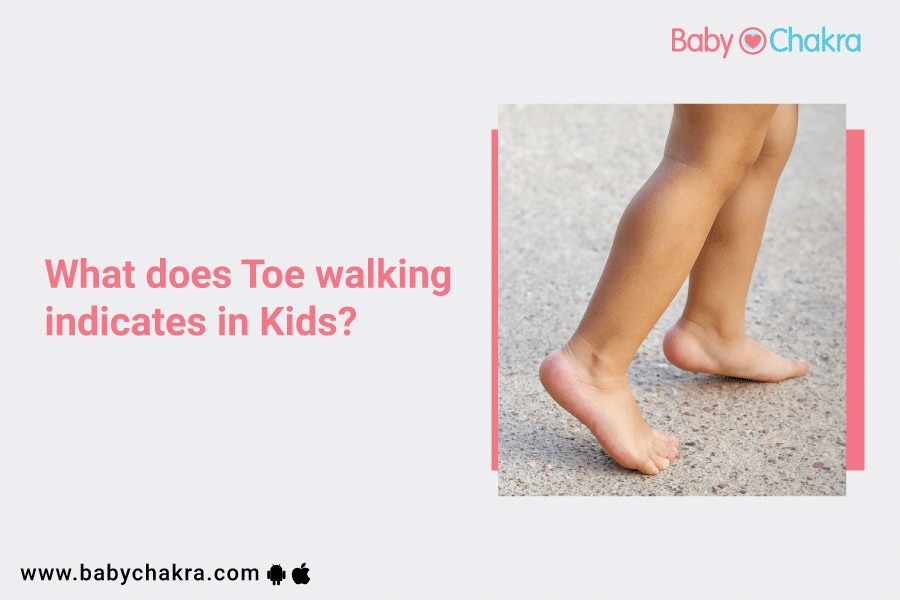
What Does Toe Walking Indicate In Kids?
17 Nov 2021 | 3 min Read
Babychakra
Author | 1369 Articles
Medically reviewed by
Dr PRADEEP Jain
When a toddler learns to walk, spend some time on their tiptoes, known as toe walking. Generally, toddlers do toe walking when they want to reach higher points, but as they perfect their walking, they walk more with their whole foot on the ground. The majority of toddlers walk with their entire foot until they are three. If your toddler is still doing the toe-walk, read this article to know what it indicates about toe walking in kids.
Causes Of Toe Walking In Kids
Toe walking in kids can be classified into four categories –
Neurological Conditions such as cerebral palsy or muscular dystrophy cause the calf muscle to get tighter or change its usual way of working. This condition makes it hard or sometimes even impossible for the child to get on their heels to walk.
Orthopaedic Conditions such as club foot or calcaneal apophysitis, which is the inflammation of the growth plate in the heel, cause toe-walking. This structural change in the foot makes the usual whole foot walk painful for toddlers, letting them walk with their toes.
Behavioural Conditions such as delay in achieving milestones can make some children walk with their toes. Toe walking in kids is also associated with autism spectrum disorders.
And lastly, some children are healthy and, with no medical conditions, persist in walking on their toes. This condition is known as idiopathic toe walking. This is also known as habitual toe walking, with the presumption that a child has formed the habit of walking on its tiptoes.
The most common observation in idiopathic toe walkers is tight calf muscles. The tight calf muscles cause difficulty in walking or running with the whole foot.
Toe Walking & Autism
Autism spectrum diseases in children have been related to toe walking in, hindering a child’s capacity to speak and engage with others. Many children with autism find it difficult to bend their ankles beyond 90 degrees, forcing them to walk on tiptoes. Autism is more common in children who walk on their toes than children who have other developmental delays.
Toe Walking Diagnosis
Under toe walking diagnosis, there are certain tests that are being done such as x-rays, CT and MRI scans, and nerve and muscle testing utilizing electrode patches or needles.
Toe Walking Treatment
Doctors can break treatment for idiopathic toe walking in kids into two types: Conservative and Surgical Intervention.
Conservative Treatment includes verbal reminders, stretching, heavy footwear, etc. On the contrary, the Surgical Intervention has primarily focused on lengthening the tough band of fibrous tissues that connects the calf muscles to the heel bone.
Toe Walking Prognosis
Toe walking prognosis has been determined by the cause of toe walking. Most children with idiopathic toe walking recover completely with therapy and learn to walk flat-footed. Even after therapy or surgery, some kids have been seen continuing to walk on their toes.
Disclaimer: This article is for informational purposes only. Talk to your doctor for the best guidance and support.
Hope you have found this article helpful; please hit the ‘LIKE’ button and ‘SHARE’ it with your friends and family.
#fortoddlers #finemotorskillsintoddlers
Related Articles:
Toe Walking In Kids: What does toe walking indicate in kids and how to cure it- know here!
Exercises To Burn Belly: These 6 best exercises will surely burn your belly faster in just 10 minutes! Sounds interesting, right? Check out the activities here!
Little Thumb: How to save your child’s cute little thumb from being sucked away to glory? Explore here!
A


Related Topics for you
Suggestions offered by doctors on BabyChakra are of advisory nature i.e., for educational and informational purposes only. Content posted on, created for, or compiled by BabyChakra is not intended or designed to replace your doctor's independent judgment about any symptom, condition, or the appropriateness or risks of a procedure or treatment for a given person.
